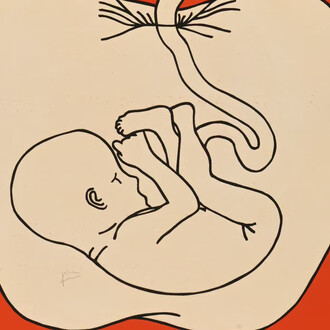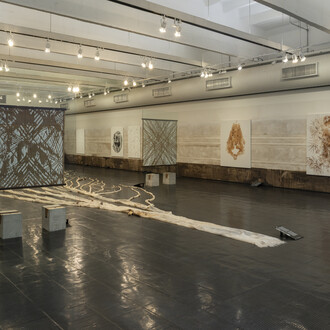The Jequitinhonha Valley is a region of tense encounters: cerrado, Atlantic forest and caatinga; indigenous communities, quilombos and Portuguese settlers; gold mining, cattle ranching and, later, eucalyptus monoculture; poverty and wealth; amazing ceramic craftsmanship and lithium extraction; the mountains and the river. It was there that Manfredo de Souzanetto was born, in a rural world that moved at a much slower pace than the urbanized regions of the state of Minas Gerais. It was in the late 1960s that the artist moved to Belo Horizonte, first studying visual arts at the Escola Guignard and, later on, architecture (we know that being an artist in Brazil often involves attending parallel and related courses in search of the stability that more conventional professions may offer). During this period in the capital, he produced several works that already questioned and confronted the disorderly exploitation of the territory by iron mining companies, creating seminal works that intervened in the natural landscape, loaded with political messages. Drawing and painting were his recurring mediums during the initial phase of his production.
In 1974, Souzanetto won the travel prize from the 5° Salão de Arte Universitária, which led him to France, where he remained for 5 years, studying photography and continuing to paint and draw. Upon returning to Brazil in 1980, he began a vast and endless investigation into natural pigments extracted from the soils of his homeland. As a continuation of the work produced in the previous decade, the artist resumed his contact with the landscape of Minas Gerais – this time, extracting the material for his works from the earth. On polymorphic canvases that break the standard rectangular format of the medium, different soil samples loaded with mineral particles (such as iron, aluminum, copper) are applied in suspension in acrylic resin, resulting in opaque surfaces in tones that range from white to black, passing through an infinite array of browns, reds, yellows, pinks and grays. In more or less saturated solutions, the colors are also applied in areas that are either geometric in shape, or lead to more fluid compositions.
The paintings from the late 1970s already revealed the artist’s interest in earthy and natural tones. The acrylic paint, however, was applied on the back of the linen, which absorbed the liquid, staining the front side with irregular contours, but with a somewhat squared appearance. The drawings from the same period often featured an organic line that referred to the outline of the mountains or the horizon, probably revealing how he missed the landscapes of Minas Gerais. In 1980, back in Brazil, the very structure of the canvas would change radically. The polygonal frames were constructed by Souzanetto himself, in his studio (located, first, in Juiz de Fora and, later, in Rio de Janeiro). The Manfredo of each city is, perhaps, also a different artist in each of the places he inhabits. His works became increasingly experimental, with new configurations and unusual volumes. In the 2000s came the complex paintings articulated from wooden triangular or square frames, sculpture-paintings assembled in arrangements that were sometimes linear, sometimes orthogonal. Recent designs present semi-circular and sinuous structures, further evoking the organic nature so inherent to the materials that the artist uses.
The works that make up “from the land, what comes…” date from 1976 to 2024, moving from geometry to organic and back to geometry, while also preserving the sentimental memory of the grounds of Minas Gerais and their colors formed by the mineral oxides present in countless soil samples collected over a journey that spans almost 60 years. For the artist, nature and landscape are a guiding thread, a point of intersection between very different embodiments. In common, his paintings emanate affection for the land, while establishing a new spatial and concrete reality by using this framework as raw material and medium. Formally, they also incorporate the statutes of sculpture and installation, playing with the fields of the two-dimensional and the three-dimensional, while residing on the threshold between abstraction and representation.
Furthermore, Souzanetto has been preserving with his pigments what men have been brutally sacrificing in the name of immediate profits and to the detriment of a sustainable future – all this since a time when ecology, environmental issues and conservation were not yet recurring, or even urgent, issues. And he continues, even today and relentlessly, to challenge himself to find other vocabularies that allow him to expand his material and symbolic language, always in contact with what the earth can offer as medium, history, inspiration and image.
(Text by Julia Lima and Luana Rosiello)















